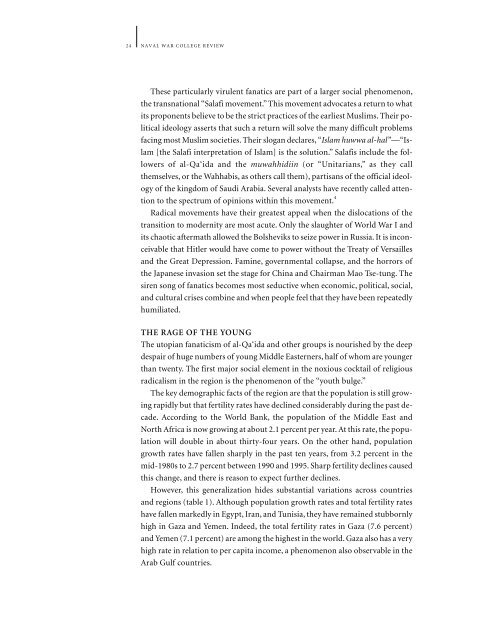Socioeconomic Roots of Middle East Radicalism
Socioeconomic Roots of Middle East Radicalism
Socioeconomic Roots of Middle East Radicalism
You also want an ePaper? Increase the reach of your titles
YUMPU automatically turns print PDFs into web optimized ePapers that Google loves.
24 NAVAL WAR COLLEGE REVIEW<br />
These particularly virulent fanatics are part <strong>of</strong> a larger social phenomenon,<br />
the transnational “Salafi movement.”This movement advocates a return to what<br />
its proponents believe to be the strict practices <strong>of</strong> the earliest Muslims. Their political<br />
ideology asserts that such a return will solve the many difficult problems<br />
facing most Muslim societies. Their slogan declares, “Islam huwwa al-hal”—“Islam<br />
[the Salafi interpretation <strong>of</strong> Islam] is the solution.” Salafis include the followers<br />
<strong>of</strong> al-Qa‘ida and the muwahhidiin (or “Unitarians,” as they call<br />
themselves, or the Wahhabis, as others call them), partisans <strong>of</strong> the <strong>of</strong>ficial ideology<br />
<strong>of</strong> the kingdom <strong>of</strong> Saudi Arabia. Several analysts have recently called attention<br />
to the spectrum <strong>of</strong> opinions within this movement. 4<br />
Radical movements have their greatest appeal when the dislocations <strong>of</strong> the<br />
transition to modernity are most acute. Only the slaughter <strong>of</strong> World War I and<br />
its chaotic aftermath allowed the Bolsheviks to seize power in Russia. It is inconceivable<br />
that Hitler would have come to power without the Treaty <strong>of</strong> Versailles<br />
and the Great Depression. Famine, governmental collapse, and the horrors <strong>of</strong><br />
the Japanese invasion set the stage for China and Chairman Mao Tse-tung. The<br />
siren song <strong>of</strong> fanatics becomes most seductive when economic, political, social,<br />
and cultural crises combine and when people feel that they have been repeatedly<br />
humiliated.<br />
THE RAGE OF THE YOUNG<br />
The utopian fanaticism <strong>of</strong> al-Qa‘ida and other groups is nourished by the deep<br />
despair <strong>of</strong> huge numbers <strong>of</strong> young <strong>Middle</strong> <strong>East</strong>erners, half <strong>of</strong> whom are younger<br />
than twenty. The first major social element in the noxious cocktail <strong>of</strong> religious<br />
radicalism in the region is the phenomenon <strong>of</strong> the “youth bulge.”<br />
The key demographic facts <strong>of</strong> the region are that the population is still growing<br />
rapidly but that fertility rates have declined considerably during the past decade.<br />
According to the World Bank, the population <strong>of</strong> the <strong>Middle</strong> <strong>East</strong> and<br />
North Africa is now growing at about 2.1 percent per year. At this rate, the population<br />
will double in about thirty-four years. On the other hand, population<br />
growth rates have fallen sharply in the past ten years, from 3.2 percent in the<br />
mid-1980s to 2.7 percent between 1990 and 1995. Sharp fertility declines caused<br />
this change, and there is reason to expect further declines.<br />
However, this generalization hides substantial variations across countries<br />
and regions (table 1). Although population growth rates and total fertility rates<br />
have fallen markedly in Egypt, Iran, and Tunisia, they have remained stubbornly<br />
high in Gaza and Yemen. Indeed, the total fertility rates in Gaza (7.6 percent)<br />
and Yemen (7.1 percent) are among the highest in the world. Gaza also has a very<br />
high rate in relation to per capita income, a phenomenon also observable in the<br />
Arab Gulf countries.
















